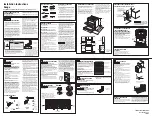
GB / IE - 6
Part 4
Maintenance and cleaning
Replacing parts
Only qualified personnel should replace faulty parts. Prior to
commencing any kind of work, disconnect the unit from the gas
distribution network and the electrical power supply.
If you remove the control panel, all the functional parts of the appliance
will be easily accessible.
Only order spare parts from the manufacturer or an authorised reseller.
Cleaning and care of the appliance
The unit must be cold when you clean it.
Keeping the appliance clean is very important for a long and trouble-free
working life.
The removable parts should be washed separately with warm water and
detergent, then rinsed in running water.
The steel parts may be cleaned with a damp cloth and with a non-
abrasive detergent and then dried by using a soft, dry cloth. For very
resistant stains, use hot water and vinegar.
Do not use harsh or abrasive detergents to clean the stainless steel
parts. Iron cleaning pads should not be used as they could cause rust.
For the same reason, avoid contact with ferrous materials, coarse
clothes or steel wool.
When cleaning, avoid using abrasive paper or cloth; in place of it, and
only in special cases, you can use pumice stone powder. In order to
remove stubborn deposits, we recommend using sponges (ex. Scotch) or
common sprays for cleaning ovens and grills. If spray products are used,
follow the manufacturer’s instructions.
The enamelled parts should not be cleaned with abrasive nor acid
products. Avoid using steel wool or metal pads for cleaning.
Preferably, clean the oven after each use: it will be easier to remove the
cooking residues and avoid burning them the next time the oven is used,
which would also result in a bad smell.
To minimise the emission of polluting substances in the environment,
we suggest cleaning the appliance with products that are at least 90%
biodegradable.
Cleaning inside the oven
Turn the electric power off or make sure you have turned off the burner
of the oven. Let the oven cool down and clean
it thoroughly with a
damp cloth
and warm water using a non-abrasive detergent (or with the
suitable products available for cleaning ovens). Do not use abrasive
cloths or pads or other products that could irreparably damage the
enamel. Normal cooking temperatures favour grease and oil splashes
becoming a mist of residual dust: it can be easily removed at the end of
the cooking process when the oven has cooled down by simply using a
damp sponge. We recommend heating the oven periodically to the
maximum temperature so that the residual dust can be removed. Be
careful not to damage the thermostat sensor placed inside the oven
while you are cleaning it.
Maintenance
The appliance needs no specific maintenance besides normal cleaning; we do however suggest having it checked once a year
by the assistance centre for which, we recommend drawing up a maintenance contract.
Safety precautions
REMEMBER THAT THE APPLIANCE:
Must never be left unattended when it is being used!
When the unit is switched on, its surfaces get very hot so please
take great care!
The appliance is designed for professional use and therefore only
qualified personnel should use it!
Installation as well as any conversion or adaptation to a different
type of gas must be carried out in accordance with current laws
and only by qualified and authorized personnel.
At least once a year have the appliance checked by qualified
personnel.
In the case of fire, close the shut-off cock to cut off
the gas supply immediately, then use a suitable fire
extinguisher to fight the fire.
Ecology and environment
Our appliances are studied and optimised, by means of lab tests, to
provide high performances and yields. However, to reduce the energy
consumption (electricity, gas and water), we suggest not using the
appliance for a long time if it is empty or in conditions that could
compromise optimum yield. All packaging materials are environment-
friendly. They can be kept without problem or burnt in a waste
incinerator plant. The plastic components that can be recycled are:
Polyethylene: external packaging material and/or polyethylene film
Polypropylene: straps
Polystyrene foam: corner pieces, sheets and protection blocks.
At the end of the appliance’s useful life, dispose of it properly. 90% of
each appliance is made of metal (stainless steel, iron, aluminated sheet,
etc.) hence it can be recycled by the relative recycling organisations in
compliance with the standards in force in your country.
Get the appliance unusable for its disposal: remove
the power cable and any locks so that no one can
get locked inside accidentally.
Содержание PFP_12GG7
Страница 1: ...Fig 1 Abb 1 рис 1 ...
















































